
A strengthening storm system over the Upper Great Lakes will bring moderate to heavy snow to the Upper Peninsula of Michigan through Tuesday morning. Ahead of this system, strong to severe storms may develop over the Ohio Valley, portions of the Appalachians, and the Mid Atlantic Monday. Read More >
James L. R. Fenix
NOAA/National Weather Service
Silver Spring, Maryland
1. THE BEGINNING & EARLY YEARS
A Joint Resolution was unceremoniously passed on February 2, 1870, and signed by President Grant on February 9th, authorizing "the Secretary of War to take observations at military stations and to warn of storms on the Great Lakes and on the Atlantic and Gulf Coasts." With this modest beginning, an agency was born under the Signal Service which would become one of the more popular and well known federal agencies. Later names of this agency would be "Weather Bureau" and "National Weather Service."
The National Weather Service (NWS) Gateway is a major component of the NWS Telecommunication Gateway (NWSTG). The Gateway began as a manual weather data collection and distribution communications center in Washington, D.C., during the Second World War. In 1942, the Joint Meteorological Committee incorporating the military and civil government weather offices was established and a Central Analysis Center was created in support of the war effort. The U.S. Weather Bureau established a communications center in the Suitland Federal Center, Suitland, MD, in suburban Washington, D.C. to collect the data for the analysis center. By 1944, the U.S. Weather Bureau, Washington, D.C., communications center used three teletypewriter machines to accomplish its mission. 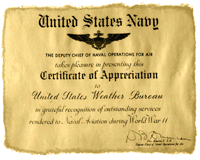 By October 1947 the International Meteorological Organization was reformed under the United Nations and the World Meteorological Organization (WMO) was established with the headquarters in Geneva, Switzerland. The WMO established the Global Telecommunication System (GTS) within the World Weather Watch in 1951 for the free and open exchange of meteorological information. Through international agreements for the exchange of meteorological data, communication circuits were established with the U.S. Weather Bureau from various international meteorological centers. The exchange of meteorological data was well established by the mid 1950's and the Washington communications center was emerging as one of the first GTS Regional Telecommunication Hubs (RTH) supporting the WMO World Weather Watch Program.
By October 1947 the International Meteorological Organization was reformed under the United Nations and the World Meteorological Organization (WMO) was established with the headquarters in Geneva, Switzerland. The WMO established the Global Telecommunication System (GTS) within the World Weather Watch in 1951 for the free and open exchange of meteorological information. Through international agreements for the exchange of meteorological data, communication circuits were established with the U.S. Weather Bureau from various international meteorological centers. The exchange of meteorological data was well established by the mid 1950's and the Washington communications center was emerging as one of the first GTS Regional Telecommunication Hubs (RTH) supporting the WMO World Weather Watch Program.
This evolving data switching operation was part of the Environmental Science Services Administration’s (ESSA) communications center in the Suitland Federal Center and grew with the addition of many more circuit connections. In 1954 the U.S. Weather Bureau, the Navy, the Air Force, MIT, and U of Chicago formed a Joint Numerical Weather Prediction Forecast Unit at Suitland MD adjacent to this growing source of raw meteorological and hydrological data. This modeling unit replaced the older Central Analysis Center, and by 1949 the communications center was operating terminal circuit equipment that ranged from nine Teletype Corporation teletypewriters including four Model 28 Automatic, Send/Receive (model 28ASR); four Model 28 Receive Only (model 28RO) to one Model 19 Automatic Send/Receive (model 19ASR).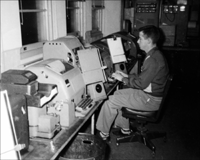 Among other circuit connections, these teletype machines were connected to a local administrative circuit, a circuit connecting U.S. forecast offices, the Civil Aeronautics Administration (CAA) the predecessor organization to the Federal Aviation Administration (FAA), and a military weather circuit. The military was a provider of significant amounts of data collected through an extensive network of radio receiver sites to intercept foreign weather broadcasts. The CAA also provided data from foreign locations through its connections to aviation weather circuits. This data exchange between circuit terminal equipment established the first operational switching center between National and International circuits. Included in these connections were radio links to some overseas locations such as Brazil. Most of these circuits operated, using punch paper tape, at a speed of 74 baud (100 words per minute).
Among other circuit connections, these teletype machines were connected to a local administrative circuit, a circuit connecting U.S. forecast offices, the Civil Aeronautics Administration (CAA) the predecessor organization to the Federal Aviation Administration (FAA), and a military weather circuit. The military was a provider of significant amounts of data collected through an extensive network of radio receiver sites to intercept foreign weather broadcasts. The CAA also provided data from foreign locations through its connections to aviation weather circuits. This data exchange between circuit terminal equipment established the first operational switching center between National and International circuits. Included in these connections were radio links to some overseas locations such as Brazil. Most of these circuits operated, using punch paper tape, at a speed of 74 baud (100 words per minute).
2. THE AUTOMATED SWITCH
By the mid-1960's, the Weather Bureau's Washington communication switch and designated RTH) was connected to over 23 FAA Service O circuits (containing International data), 6 FAA Service C circuits (containing warnings and forecasts), 60 FAA Service A circuits (containing aviation data), 4 Radar Warning and Coordination teletype circuits (called RAWARC), and several facsimile circuits as well as to the International circuits of the GTS. 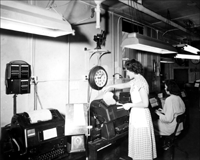 The circuit now being used to exchange meteorological data with the DoD was connected to the military weather switching facility located at Tinker Air Force Base, Oklahoma, which was an automated computer-to-computer connection. The circuit directly connected the Weather Bureau’s IBM 2908 controller operating through a RIXON modem at 3600 bits per second to the U.S. Air Force. This was the first high-speed communications circuit for the center in Suitland, Maryland.
The circuit now being used to exchange meteorological data with the DoD was connected to the military weather switching facility located at Tinker Air Force Base, Oklahoma, which was an automated computer-to-computer connection. The circuit directly connected the Weather Bureau’s IBM 2908 controller operating through a RIXON modem at 3600 bits per second to the U.S. Air Force. This was the first high-speed communications circuit for the center in Suitland, Maryland.
By early 1960 the Weather Bureau Communications (WBC) Center was well established in Suitland, MD, and was supplying the Joint Numerical Weather Prediction Center (JNWP), which evolved from the Central Analysis Center (CAC), with the observational data needed to make surface and upper air analysis and forecast charts. The JNWP was jointly operated by the Weather Bureau and the U.S. Air Force Air Weather Service. The communications center began passing observational data to the JNWP by punching cards from paper tape and reading the cards into an IBM 1401 computer. The electrical delivery of data directly into a computer was developed in mid 1966. This capability marked the beginning of the true automation of the WBC center in Washington, D.C.
By early 1966, the center acquired two IBM 360 model 30 computers that were connected to the communications switching center teletype circuits with electrical interfaces provided through an IBM 2702 communications controller and a modified IBM 2908 communications controller modified to accommodate unique weather protocols. These communication controllers came with the delivery of the IBM 360 model 30's in 1966. The machines collected all of the observational data and placed the data on MEMOREX 2314 disk drives for computer ingest into the new Automated Data Processing software where data recognition and decoding was accomplished. The IBM 360 mainframe computer ran a new IBM communications software operating system called Communications Control and Applications Program (CCAP) [pronounced "See-CAP"). This software was heavily modified for weather data processing jointly by IBM and government staff. The software provided the data for the JNWP model software and was the nucleus for true automated data switching. This software system supported many circuits now connected to the front-end communication controllers. The IBM 2702 controllers replaced the manual tearing of baudot paper tape. The FAA lines [Service A, C, and O] now were feed directly into these new communication controllers at 100 words per minute.
The first international high-speed circuit was implemented between the WBC and Tokyo, Japan, in July using Fujitsu modems at 2400 bps with 75 baud back channels utilizing the WMO bisync protocol. In January 1970, a 2400 bits per second link was installed with Europe connecting Washington with Offenbach, West Germany. This connection was later moved to Paris, France and finally established with the British meteorological communications center in Bracknell, UK. The Washington RTH was the only major automated weather computer center as a component on the GTS at this time. The generated products from the JNWP included manually drawn weather charts that were transmitted on analog facsimile circuits using ALDEN Corporation flat-bed scanners.
3. UPGRADE
Three IBM 360 model 40's were purchased in early 1970, to upgrade the capabilities of the message switching functions. They were soon integrated into the communications center and the IBM data switching CCAP software was enhanced to transmit and receive message traffic automatically on many additional lines. This replaced the manual switching methods using the teletypewriters paper tape for receipt and transmission of messages. A new IBM 2703 communication controller was added to the IBM 360 for direct line connection. These communication controllers supported interface speeds from 50 baud BAUDOT code (74 words per minute) to 3600 bps ASCII code. The IBM 360 computers were linked using shared disk technology which operated Memorex 2314 disk drives. One 360 model 40 was loaded with a new DOS operating system for the meteorological data recognition decoding to properly identify the various types of environmental reports and than the passing of the decoded data to the modeling computers. Additional links were installed using the new WMO bi synchronous communication protocols in ASCII character code, eliminating the older BAUDOT 5-level tape code which often contained many errors during transmission.
By 1974, new communication controllers were installed. These Interdata 50 computers contained WBC designed and built interface cards and line driver software permitted faster more efficient communications by connecting lines directly to the IBM 360 Model 40 computers. The NWS was now supporting a major computerized WMO Regional Telecommunications Hub (RTH) of the increasingly automated GTS. This new computer was operated by the Washington RTH and was the only RTH located in North America, making it a major hub of the GTS.
4. A MAJOR SWITCH
By late 1974, the Gateway had evolved to a completely automated switching center utilizing three IBM 360 model 40 computers for switching and decoding and an IBM 360 model 30 computer for facsimile processing and transmission. The model 30 was modified from its role of feeding the National Meteorological Center (NMC) computer model software to a support role in the automation of facsimile transmissions and the IBM 360 model 40's took on the task of communications with the NMC. These same model 40's supported the switching of the majority of the other circuits, which now numbered close to 90. The WMO international links had increased in number and lines exchanged data with Brasilia, Brazil, Buenos Aires, Argentina; Tokyo, Japan; Bracknell, UK; and Toronto, Canada. Many of the circuits connected to the Washington communications center were installed in support of aviation operations.
The growth in national circuits included many FAA circuits such as the Automated Fixed, Telecommunications Network supporting the International Civil Aviation Organization (ICAO). The military circuits, operated by the Air Force’s Air Weather Service, provided NWS offices throughout the 50 states with data from military bases in the continental U.S. and overseas. The commercial airline community was supported directly from the IBM 360 Model 40 systems on dedicated circuits from the IBM 2908 controller at 1050 bps ASCII with tailored flight level wind products. The Washington communications center exchanged data with the main FAA Weather Message Switching Center in Kansas City, MO. Specially formatted data, surface observations and forecasts for many foreign locations were provided to the FAA through the FAA.
The manual facsimile broadcasts were changed to automated transmissions in 1975 and special, encoded methods (DIFAX) were employed. This was accomplished with new Interdata 50 communication controllers which were programmed especially for analog transmission using NWS designed communication interface boards. This allowed the removal of the old ALDEN Corporation flat-bed scanners.
The National Oceanic and Atmospheric Administration (NOAA) administrative was a newly formed government organization containing both the now National Weather Service (NWS) and the National Environmental Satellite , Data, and Information Service (NESDIS). The NWS provided a traffic distribution function, which required manual reading of messages before switching to local government circuits and/or to the AUTODIN (an automated defense communication network). This operation was moved to the World Weather Building in 1974. New lines connecting the automated message switch in Suitland with the NOAA message center were installed for exchange of needed meteorological traffic not received with proper message identification.
5. THE GATEWAY
The 1976 time frame saw the development of the Weather Service's Automation of Field Operations and Services (AFOS) combined communications and forecast office workstation set of systems. The NWS National Meteorological Center (NMC) containing both the communications switching system (called the Gateway) and computer modeling center began distributing large amounts of NMC products to the Weather Service field offices through the Gateway connection to a new Systems Monitoring and Control Center (SMCC). The use of the name Gateway for the communications switching system now began. This began the exchange of large volumes of centrally produced products for delivery to the Weather Service Forecast Offices across the United States. The major international forecast centers were evolving, which demanded that larger volumes of data and products be exchanged. These increasing requirements required increased circuit speed ,and by1980, many international circuits were operating at 4800 bps using the WMO ASCII (alphabet 5) format. The NMC was producing larger and larger global forecast fields from the models. The military exchange increased and circuit speeds increased to 4800 bps with dual links installed for backup with the Air Force's Automated Weather Network located in Carswell Air Force Base, Texas. Links to Toronto, Canada, and many federal agencies were now operating at speeds of 4800 bps.
6. MAJOR UPGRADE PERIOD
The Gateway began a series of major upgrades in 1979 and a redesign of the Gateway was undertaken by NMC. By 1982, the Gateway was again upgraded and the IBM 360 model 30 and model 40's were replaced with IBM 4341 mainframes. The operating software installed on the new mainframes was the Virtual Machine (VM) operating system. This allowed the continuation of the CCAP switching function as it moved from the IBM 360 model 40 to the IBM 4341. The lines of communication had grown to 120 circuits and the interface to the new NMC forecast model producer was changed to a disk sharing process for rapid exchange of data and products between the Gateway and the computers of the modeling center. New Concurrent 3210 communication controllers were designed and programmed between 1979 and 1982 to replace the older IBM 2702 and 2703 controllers driving the older, low-speed circuits. The Gateway had replaced MEMOREX 2314 disk storage devices with IBM 3330 disks in 1982. The NMC aviation forecast computer model was producing forecast fields in a new binary code form called GRIB by 1986. The WMO agreed upon the newly developed X.25 communications protocol which was subsequently installed at the Gateway in 1985, after the purchase of the IBM 3705 and IBM 3725 communication controllers. These devices handled the WMO connections that operated as ASCII at 4800 bps, 9600 bps.
New circuits were installed between the Gateway and Tokyo RTH and between the Gateway and the Bracknell RTH using the X.25 protocol in 1987. At this same time, a suite of new circuits were established. This was known as the Family of Services data distribution system and was established to provide the data available at the Gateway to the general user community. The older 1050 bps speed connections to dedicated airline users were eliminated. The Numerical Products Service was established for the delivery of new binary GRIB coded aviation forecast gridded products to the general user community at 4800 bps using the X.25 protocol. The connection to the Navy Fleet Numerical Oceanographic Center was upgraded to X.25 protocol by 1988.
7. NWS INTERNAL ORGANIZATIONAL TRANSFER
The Gateway was included in the new NWS Headquarters reorganization and was moved into the newly formed Office of Systems Operations in 1986. This moved the management of the Gateway from the NMC's Automation Division to the Systems Operations Center under the Office of Systems Operations. However, it physically remained at Suitland Federal Center along with the AFOS SMCC.
The Gateway was now a part of the NWSTG, which was a combined SMCC, major message switch, monitoring of other NWS services, and the Automated Surface Observing System (ASOS). The NWSTG was a major provider of data and products for the NWS Forecast Offices, a major RTH center on the WMO GTS Main Trunk Network, a front-end data distribution center for the NMC, a major aviation meteorological data provider for the FAA, and the provider of the Family of Services data streams on 4 separate circuits. The NMC had a role as one of two World Area Forecast Centers (WAFC) for ICAO-generated products. An even larger set of forecast products was available, which caused an increase in data flow. The other WAFC for ICAO support was Bracknell, England. Thus, there was an increase in the data exchange between the two centers and this required the Gateway to increase the Bracknell GTS link line speed to 9600 bps by 1987 and later to 14.4 Kbps to meet the exchange requirements. The Gateway added new IBM 3375 disk drives for added capacity in 1987 and in 1988 for the AFOS binary graphics products and WAFC GRIB.
New digital graphics products for supporting a new NWS field upgrade to replace AFOS was started in 1987. The Gateway began the development of a new interface at 56 Kbps to meet the new Advanced Weather Interactive Processing System (AWIPS). The initial phase was a system called the Information Stream for AWIPS NOAAport (ISPAN) that required multiple virtual circuits for ASCII, BUFR, GRIB, and Red-Book digital Graphics coded products for transmission to a major NWS modernization development in Norman, Oklahoma, and Denver, Colorado. There, new field automated work station sites were being established and required the data streams ultimately planned for AWIPS. This initiated the next phase of upgrade for the Gateway.
8. THE BIG MOVE
To accomplish this next upgrade, the Gateway began plans for relocation from Suitland, Maryland, to a newly built Metro Center II building in Silver Spring, Maryland. The connection to NMC was changed from disk sharing to an File Transfer Protocol (FTP) file transfer bridge in 1989 between the two different operating systems, as the NMC was MVS and the Gateway was VM/SP. The move also required the installation of new hardware.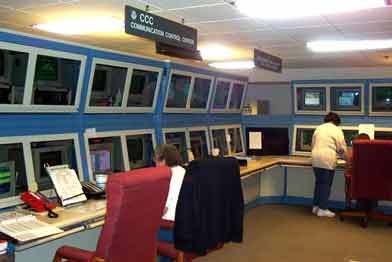 The consolidation of the SMCC, Gateway, NOAA message center and Communications Control Center (CCC) in one facility on the sixth floor of the new building was accomplished. The NWSTG was relocated.
The consolidation of the SMCC, Gateway, NOAA message center and Communications Control Center (CCC) in one facility on the sixth floor of the new building was accomplished. The NWSTG was relocated.
The Gateway moved from the IBM 4341 computers to HDS 9060 mainframes in Silver Spring, Maryland. The move was accomplished in July 1992 after the installation of a newly purchased AMDHAL 4745 in 1991 to replace the IBM 3705 and 3725 communication controllers left behind at Suitland, Maryland, along with the IBM 4341's. At this time all lines were bridged between Suitland and Silver Spring and new DataSwitch, Incorporated line switching equipment was installed at the CCC.
The new Gateway of 1992 had three HDS 9060 mainframes, three strings of HDS 7380 disks, and two strings of IBM 3375 disk drives. The communications controllers were an AMDHAL 4745, two Concurrent 3210 computers, and a CNT-CTC devices with T-1 lines for the connection between NMC in Suitland and the Gateway in Silver Spring. A LAN connection was established for TELNET access for the World Weather Building for use in reestablishing their console connection to the Gateway host system. Increased data storage needs required additional disk storage, and new EMC2 RAID storage technology disk units were installed in 1993. The international circuits to Buenos Aires and Brasilia were upgraded to X.25 protocol at 9600 bps in 1994, and the link to Tinker Air Force Base, Oklahoma, (relocated from Carswell Air Force Base, Texas, in 1993) was upgraded to using the X.25 protocol in 1994 operating at 19200 bps.
9. DATA ACCESS
The Gateway added to its LAN technology in 1994 and introduced FTP file servers. This began a move to a client/server network centric architecture operation. Plans were being made in the middle of 1994 to design the Gateway with extensive downsizing of a mainframe architecture to a distributed operations on a high-speed backbone LAN. This change along with the addition of UNIX-based operating systems and file sharing devices, gives the Gateway more flexibility for interfacing with newer communication technologies.
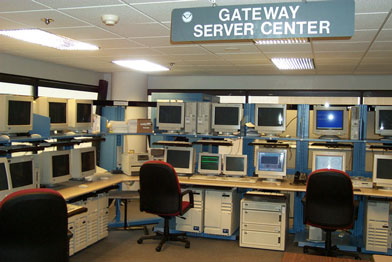
By late 1994, the Gateway had added two new IBM RISC 6000's, a CISCO 7000 router, and a FDDI Backbone. New file servers supporting FTP, HTTP, and Gopher software were installed, and large amounts of data were made available at the Gateway on file servers. This permitted servers to establish a connection using the Internet. This established a standard means for data retrieval of documentation information using Internet browsers and retrieving meteorological and hydrological data interactively. The access to the data passing through the Gateway was now available using standard access methods on any client. The NWS Home Page and other documentation was made available in early 1995. The forecast offices began accessing large amounts of NMC model products using FTP over T-1 TCP/IP and Frame Relay links in 1995.
10. FIRST FIFTY YEARS
The first 50 years of the Gateway (1945 -1995) saw the growth from a small data collection room in Washington to a large computer facility in Suitland MD. The Gateway began by using the teletype paper tape for supplying information for hand plotted charts and ended as a highly automated switching system processing millions of data characters per day for switching between local forecast offices and among foreign centers and distributing model products both nationally and internationally.
11. THE THIRD UPGRADE
The third upgrade began to take place in mid 1995. The selection process resulted in the purchase of an IBM 9673-R32 CMOS switching engine and LAN based processors for data processing and a new data base was developed using Sybase SQL architecture in early 1996. A first IBM 9673-R32 system was delivered in October 1996. New communications with NCEP and the DoD were installed in advance of the Gateway hardware upgrade. The NCEP moved operations in 1996 to the UNIX platform on Cray computers and the FTP protocol was used between the Gateway and NCEP on an new 10 mbps FNS using Ethernet protocol between routers. This process by NCEP removed their HDS 9080s and the MVS operations stopped production by early 1997. The DoD connection was upgraded to ATM for NWS to DoD sites of AFGWC and FNMOC in 1996. The Gateway started the NCEP DBnet transfer of files from the NCEP site to Gateway local file servers for use by the NWS field sites directly connected to the Gateway routers by November 1996.
The operational Gateway IBM 9672-RB4 system and backup system were installed October 1997 and made operational in January 1998. The Gateway HDS 9060s were removed in Early February 1998. The LAN Website was upgraded and moved to IBM 6000/F50 processors in April through July 1998 and the OSO File Server was upgraded on IBM 6000/H50 systems to meet the needs of additional capacity in July 1998. The final Gateway installation of central switching engine and LAN based processors combination was in place by July 1998. The NWSTG now operated a major Internet accessible file server system and web server environment as a provider of current observational and model forecast products.